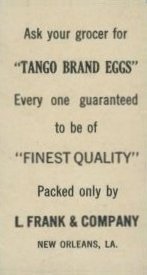 Old Cardboard Website Sponsor |

|
|
| Home N-Cards D-Cards E-Cards F-Cards M-Cards R-Cards T-Cards W-Cards Postcards Pins Game Cards Foreign Others | |
1916 Tango Eggs
 FRONT |
 BACK |
Hobby Designation: -- Set Name: Tango Eggs Card Size (inches): 1-7/16 x 2-3/4 Number of Cards in Set: 20 Est. Value (common; VG): $900 Player Checklist Card Gallery Tango Eggs on eBay Google Search |
| (shown at approximate actual size) | ||
Set Summary | ||
|
After laying dormant for three-quarters of a century, a hoard of about 750 of these Tango Eggs cards surfaced in 1991. The set was not known to collectors prior to that time, and is therefore unlisted in the American Card Catalog. The cards were apparently distributed (or intended for distribution) as a promotion for Tango Brand Eggs, a product of L. Frank & Company of New Orleans. The cards share the same size and design (and in some cases, use the same player poses) as those produced by caramel card makers of the period. The Tango Eggs set's closest relative is the E106 American Caramel set produced one year earlier. The brightly colored white-bordered cards are printed on a noticeably glossy surface. The player's name, position, team and league affiliation are printed at the bottom of each card. The card backs carry promote the company's product as "guaranteed to be of 'FINEST QUALITY'" and "Packed only by L. FRANK & COMPANY" of New Orleans.
"I bought a couple of Tango Eggs cards from a dealer about ten years ago," says New Orleans collector Scott Whittenburg, who currently holds the #1 position on the PSA Set Registry for this set. "I didn't think much of them at the time, but they've become more popular and much more expensive. Since I live in New Orleans the cards are especially interesting for me." The 1-7/16" by 2¾" cards are quite similar to the 1915 E106 American Caramel set. You'll find some familiar portraits here, nicely embellished with riotous colors on glossy stock. The reverse carries an advertisement for "TANGO BRAND EGGS" of "FINEST QUALITY." Since an egg company sponsored the cards it is irresistible to note that four of them are scrambled. The Happy Felsch card doesn't picture Mr. Felsch; instead, there's a portrait of Ray Demmitt. Buck Weaver's card actually pictures Joe Tinker of the Hall of Fame trio of Tinker-to-Evers-to-Chance. Ray Morgan has a card, but it's Mike Doolan who's pictured. Billy Meyer's card features a picture of none other than Fred Jacklitsch. Most of the known examples of this series are either Hughie Jennings or Bob Bescher cards. The PSA Vintage Population Report shows that the Buck Weaver/Joe Tinker card is submitted for grading even more often than the Bescher, but expert Brian Daniels states that this is a statistical aberration as there are roughly five times as many Bescher cards as those of Weaver/Tinker. "I bought the whole Tango Eggs deal after it had passed through three dealers' hands," Daniels stated. "The Buck Weaver cards had been pulled from it by then because a Chicago dealer wanted them. A few other cards were pulled along the way as well, including the two Cobb specimens." Two Cobb specimens? Don't the catalogs state that there's only one Cobb "Egg" in existence? "There are two," Daniels said, "and they're in different poses. I have only seen one of them, but the other was handled by a totally reliable source at Mastro so I know that it exists." Much of the hoard survived in excellent condition and PSA has certified more than 40 examples in NM-MT 8 (some with qualifiers) but no Mint 9 or better specimens. "Most of the cards in the hoard were off-center," Daniels said. "That's just the way they came." Are there any new discoveries being made in the series? "A few of them have trickled in. I bought one of the rarities from a dealer who was saving it for his kid's college education," Daniels explained. "I offered him so much for it that he just pulled it out his secret hiding place and sold it to me." The 1916 Tango Eggs set is filled with major rarities, but more and more collectors are taking up the challenge as the interest in vintage cards escalates. Bruce Amspacher has been a professional writer since the 1950s and a professional numismatist since the 1960s. He won the OIPA sportswriting award in 1958 and again in 1959, then spent eight years in college studying American Literature. This background somehow led him to become a professional numismatist in 1968. Since then he has published hundreds of articles on rare coins in dozens of publications as well as publishing his own newsletter, the “Bruce Amspacher Investment Report, for more than a decade. His areas of expertise include Liberty Seated dollars, Morgan and Peace dollars, United States gold coins, sports trivia, Western history, modern literature and the poetry of Emily Dickinson. In 1986 he was a co-founder of the Professional Coin Grading Service (PCGS). Today he is a full-time writer for Collectors Universe.
| ||
| Home N-Cards D-Cards E-Cards F-Cards M-Cards R-Cards T-Cards W-Cards Postcards Pins Game Cards Foreign Others | |
|
Copyright 2003-2023. Suggestions and corrections from all viewers are always welcome and appreciated. | |